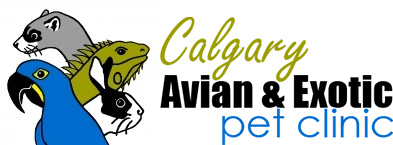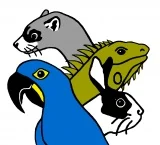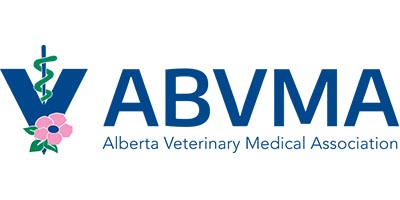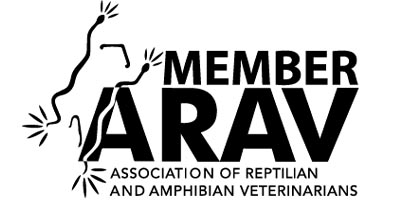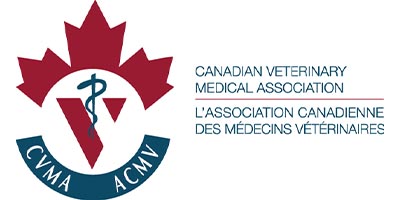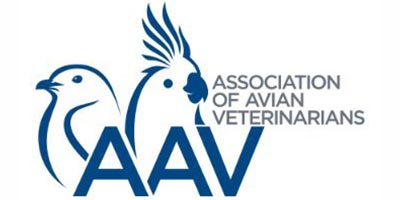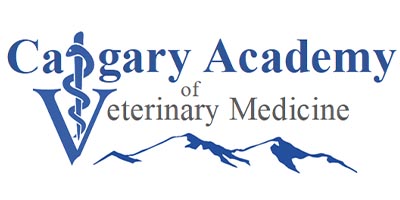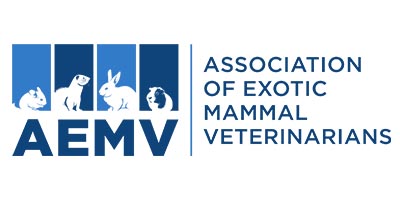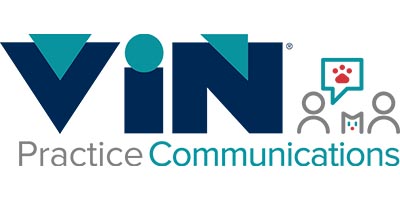The sugar glider is a member of the gliding possum family, native to Australia and New Guinea. This arboreal, nocturnal creature spends its days in leaf- lined nests in tree hollows. Sugar Gliders have unique features. This small marsupial possesses a gliding membrane, called a patagium, which extends from the 5th digit on the forepaw down to the 1st digit of each hind foot. Each hind foot has an opposable clawless toe that enables the glider to firmly grasp the branches it lands on. Sugar Gliders are colony animals that engage in social grooming and the 2nd and 3rd toe of the hind foot are partially fused to form a grooming comb. Gliders are territorial and engage in a series of vocal, visual and chemical cues to communicate.
DIET: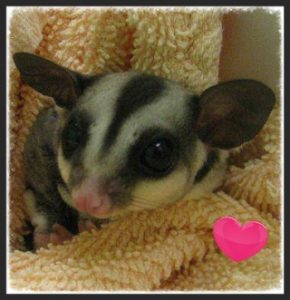
Sugar Gliders are omnivores, naturally feeding on insects, larvae, arachnids and small vertebrates during the spring and summer. Eucalyptus sap or tree gum, blossoms and nectar make up the bulk of the diet during the autumn and winter seasons and their incisors are specialized for gouging tree bark to obtain the gum. Recreating such a specialized diet in a captive situation is challenging, not only in providing a balanced diet, but because Gliders will gorge on sweeter food items to the exclusion of nutritionally sound choices often resulting in severe nutritional deficiencies.
The following diets are two different approaches to feeding pet Gliders. As with all exotic pets, information on nutrition is continually evolving as more is learned about the needs and issues in captivity. Glider owners are encouraged to continually seek updates on best feeding recommendations.
The following recipe comes from the Taronga Zoo and is measured to feed two Gliders:
Apple (3 g)
Banana/corn (3 g)
Grapes/kiwi (3 g)
Pear (2 g)
Melon (2 g)
Orange with skin (4 g)
Sweet potato (3 g)
Dog kibble (1.5 g)
Fly pupae (1 tsp)
Leadbeater’s mixture (2 tsp) *see below
Day-old chick, when available (once weekly)
Large insects, mealworms once weekly
*Leadbeater’s Mix: 150 ml warm water, 150 ml honey, 1 shelled boiled egg, 25g high protein baby cereal, 1tsp vitamin/mineral supplement, and 100mg calcium carbonate. Mix water and honey. In a separate container, blend egg until homogenized and gradually add vitamin/mineral powder, then baby cereal, blending after each addition until smooth. Keep refrigerated. The mixture can be frozen in ice cube trays.
With the availability of more complete diets, newer recommendations suggest the ideal daily diet for a pet Sugar Glider should include a nutritionally-balanced, extruded kibble, a calcium-based multi-vitamin, and fresh fruits and vegetables. Both the kibble and multivitamin should be formulated specifically to meet the unique dietary requirements of Sugar Gliders. Two of the more commonly available kibble choices are Glide-R-Chow (www.sugarbears.com) and NutriMax (www.vetspride.com). Gliders must be taught to eat kibble and sweetening it with applesauce or a fruit juice often encourages intake.
Fresh fruit and vegetables should make up 25% of the daily diet. Because Sugar Gliders will over-eat sweet items, strict proportioning should be practiced. Apples can make up the primary fruit source, supplemented with other fruits for variety such as blueberries, melons, pears, or other seasonal fleshy fruits. Both fruits and vegetables should be washed and organic when possible. Overuse of fruits or vegetables considered high in oxalates (blackberries, raspberries, strawberries, carrots, spinach, pears, lettuce, figs, collard greens, and beets) could result in calcium deficiency.
Treats should not make up more than 5% of the daily diet. Gliders should be monitored for any change in appetite or stool when a new food item is introduced.
Avoid pesticide treated fruits or vegetables, fats, and dairy products. Gliders do not naturally eat seeds, nuts or grains and such items have poor nutritional value and can predispose the Glider to choking. High sugar items such as fresh corn, grapes or raisins should be given rarely.
HOUSING: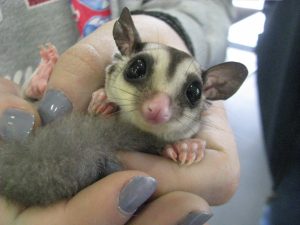
Sugar gliders are social animals that typically live in groups of five to twelve, so keeping a single animal is not recommended. If circumstances find a Glider alone, a minimum of 2 hours per day of human handling helps fill the Glider’s need for community. Glider groups are exclusive and they are extremely territorial, so introduction of new Gliders must be carefully monitored.
Cage sizing should always be as large as possible and tall, wire birdcages are a suitable choice. Wire spacing should be no more than 2.5 x 1.3 cm and horizontal rather than vertical bars allow the Glider better grip for moving about the sides of the cage. Cage furniture should include items for visual security (hide box, sleeping pouch) as well as exercise and enrichment (branches, shelves, solid running wheel, swings, bird toys). Gliders can enter torpor if too cold. Ideal temperatures range from 24-27°C (75-80°F) and supplemental heat is recommended during the winter months.
HANDLING:
Gliders communicate by visual and chemical cues and if socialized early in life (7-12 weeks of age), can adapt to human handling. Excess handling and removal from a nest site, especially for a young joey, can cause significant stress, predisposing the animal to serious illness. Draping a towel over the Glider and then grasping it with the towel is preferred over bare hand grabs during the habituation stage.
PHYSIOLOGY:
Female Gliders are smaller than males and body weight ranges from 80-160 grams. The average captive life span ranges from 5-10 years. Gliders are sexually mature between 8 (females) – 12(males) months. Gestation is 14-17 days, after which the joey travels from the birth canal into the pouch where it continues to grow for 70-75 more days. Gliders typically have 1-2 young that wean between 110-120 days. Both the male and female have unique reproductive features. Males have a bifurcated penis, which splits about halfway down the protrusion. The testicles are visible in a pendulous scrotal sac. Females have two uteri and a pouch mid-belly where the joey continues its growth. The males have obvious scent glands, the most visible on the forehead.
WHEN TO CALL A VETERINARIAN: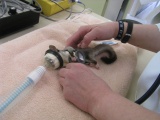
Annual physical examinations are recommended for all pet Gliders, including an initial fecal evaluation. Given the specialized nature of this species, many of their problems are related to captivity. Common medical concerns include:
Nutritional deficiencies / indiscretions: Common in Gliders, deficiencies can result because of inappropriate feeding or from selective eating. Calcium deficiency is the most common and Gliders can develop rear leg paresis, incoordination, trembling, falling and softening and malformation of the bones. Seizures can result. Excess intake of sugars and starches can result in obesity and cataract formation.
Dental disease: Dental plaque and concurrent gingivitis are also a result of sugar and starch in the diet and scaling and cleaning the teeth can be necessary to prevent severe periodontal disease.
Urinary tract disease: Gliders can develop infections of the urinary tract including stone or crystal formation and urinary tract blockage.
Stress disorders: Gliders manifest stress in several ways including hair pulling, self-mutilation, eating disorders, diarrhea and over-all poor health. Attending to both their basic and psychological needs is paramount in keeping a healthy Glider.
Trauma and poisoning: Sugar Gliders are naturally curious animals and with their ability to move quickly, can get into all sorts of trouble when out of their enclosures. Close supervision and serious pet proofing of an area is necessary. Food items (bowls of nuts, sweets, butter, partially full drink glasses) should all be removed. Access to plants and ashtrays should be prevented. Ceiling fans should be off and there should be no access to open water (sinks, toilets, tubs). Sugar Gliders are remarkably sensitive to aerosol fumes and spray cleaners and air fresheners should be avoided. Gliders should be housed away from the kitchen and removed from the household if the oven is put through the self-cleaning option or any home renovations are being done (painting, staining). Interaction with other pet species should be discouraged and younger family members should be closely supervised if handling the Glider.
THIS INFORMATION IS MEANT AS A GUIDELINE ONLY AND IN NO WAY REPLACES CONSULTATION WITH A VETERINARIAN.
